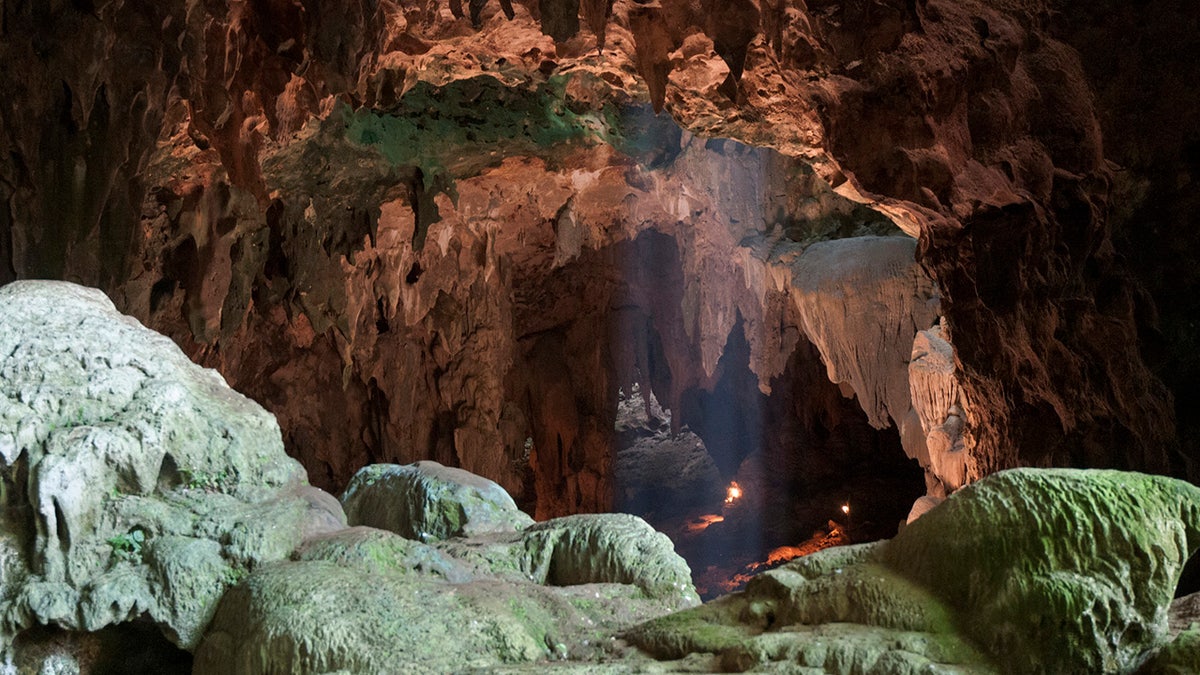
This undated photo provided by the Callao Cave Archaeology Project in April 2019 shows Callao Cave on Luzon Island of the Philippines, where the fossils of Homo luzonensis were discovered. This view is taken from the rear of the first chamber of the cave, where the fossils were found, in the direction of the second chamber. (Callao Cave Archaeology Project via AP)
Fossil bones and teeth belonging to at least three individuals found in a cave in the Philippines have revealed a new species of human that walked the earth nearly 50,000 years ago, researchers say.
Based on bone and teeth fragments found on the island of Luzon, researchers say our distant cousins stood less than 4-ft tall and had several ape-like features. The bones that were found – from the feet, hands and thighs - are human and from a previously undiscovered species.
EXTINCT HUMAN SPECIES LIVED TOGETHER IN SIBERIAN CAVE NEW RESEARCH SHOWS
Archeologist Armand Salvador Mijares made the first discovery in 2007. He was digging in the Callao Cave and found a toe bone.
“There’s something peculiar with this bone,” he told NPR and then continued digging.
The find is another reminder that we, Homo sapiens, are the only surviving member of our branch on the evolutionary tree. It’s also a reminder that we’ve had company for most of our existence.
Expert Matthew Tocheri of Lakehead University in Thunder Bay, Ontario, says the discovery also makes the understanding of human evolution in Asia “messier, more complicated and whole lot more interesting.”
In a study released Wednesday in the journal Nature, scientists describe a cache of seven teeth and six bones from at least three individuals. They were found in the cave in 2007, 2011 and 2015.
Tests on two samples show minimum ages of 50,000 years and 67,000 years.
THE OLDEST ICE ON EARTH MAY BE HIDING 1.5 MILES BENEATH ANTARCTICA
The main exodus of our own species from Africa that all of today's non-African people are descended from took place around 60,000 years ago.
Analysis of the bones from Luzon led the study authors to conclude they belonged to a previously unknown member of our "Homo" branch of the family tree. One of the toe bones and the overall pattern of tooth shapes and sizes differ from what's been seen before in the Homo family, the researchers said.
They dubbed the creature Homo luzonensis.
The new species used stone tools and its small teeth suggest it might have been rather small-bodied, said one of the study authors, Florent Detroit of the National Museum of Natural History in Paris.
Homo luzonensis lived in eastern Asia at around the same time as not only our species but other members of the Homo branch, including Neanderthals, their little-understood Siberian cousins the Denisovans, and the diminutive "hobbits" of the island of Flores in Indonesia.
There's no sign that Homo luzonensis encountered any other member of the Homo group, Detroit said in an email to The Associated Press. Our species isn't known to have reached the Philippines until thousands of years after the age of the bones, he said.
But some human relative was on Luzon more than 700,000 years ago, as indicated by the presence of stone tools and a butchered rhino dating to that time, he said. It might have been the newfound species or an ancestor of it, he said in an email.
Detroit said it's not clear how Homo luzonensis is related to other species of Homo. He speculated that it might have descended from an earlier human relative, Homo erectus, that somehow crossed the sea to Luzon.
WOOLLY MAMMOTH MYSTERY SOLVED? STUDY REVEALS SHOCKING DETAILS ABOUT PREHISTORIC CREATURE
Homo erectus is generally considered the first Homo species to have expanded beyond Africa, and plays a prominent role in the conventional wisdom about evolution outside that continent. Some scientists have suggested that the hobbits on the Indonesian island are descended from Homo erectus.
Tocheri, who did not participate it the new report, agreed that both H. luzonensis and the hobbits may have descended from H. erectus. But he said the Philippines discovery gives new credence to an alternate view: Maybe some unknown creature other than Homo erectus also slipped out of Africa and into Europe and Asia, and later gave rise to both island species.
After all, he said in an interview, remains of the hobbits and H. luzonensis show a mix of primitive and more modern traits that differ from what’s seen in H. erectus. They look more like what one what might find in Africa 1.5 to 2.5 million years ago, and which might have been carried out of that continent by the mystery species, he said.
The discovery of a new human relative on Luzon might be “smoke from a much, much bigger fire,” he said.
CLICK HERE FOR THE FOX NEWS APP
Michael Petraglia of the Max Planck Institute for the Science of Human History in Jena, Germany, said the Luzon find “shows we still know very little about human evolution, particularly in Asia.”
More such discoveries will probably emerge with further work in the region, which is under-studied, he said in an email.
The Associated Press contributed to this report.
